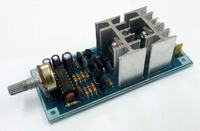sweetguy4sure
Newbie level 3

Hi , i found your forum and i need some direction, im stuck on a project and have no idea how to solve the problem i have . First off im a mechanic and i have some electrical and mechanic backround. im also familiar with computers. im weak in electronic circuits. Im working on a project for cars that will help save alot of fuel with hydrogen fuel cell.I net good gains of fuel savings now but i want to go to the next step in the project. here is what i need . i need a type of controller that is able to control up to a 30 amp 12-14vdc out on a variable 1-3 volt input. In other words i can tap off the throttle postion sensor in the car that is 1 volt at idle (throttle closed) and 3 volts (throttle wide open). i need this to control a 30 amp unit through a pot or relays. 30 amps being wide open and 5 amps being idle.i need the amperage to correspond to the 1-3 volts the throttle position sensor .im using a 30 amp pulse width modulator that has a varible pot on it. i need to be able to control this pot with the throttle response. that would allow the system to gain even more mpg.allowing the fuel cell to be variable will allow the fuel curve to match alot better then just one set point as its designed today. any ideas? anyone? thank you for your time


